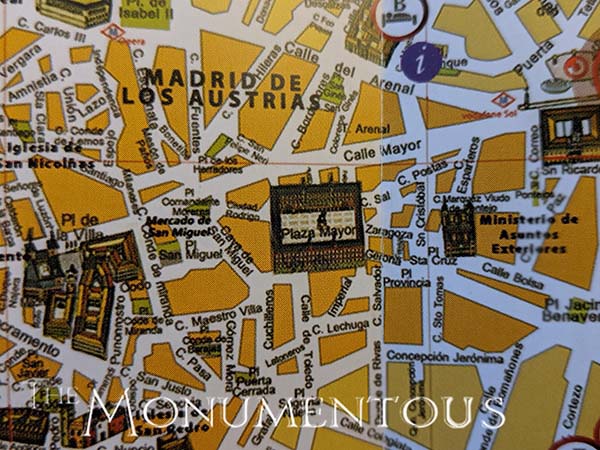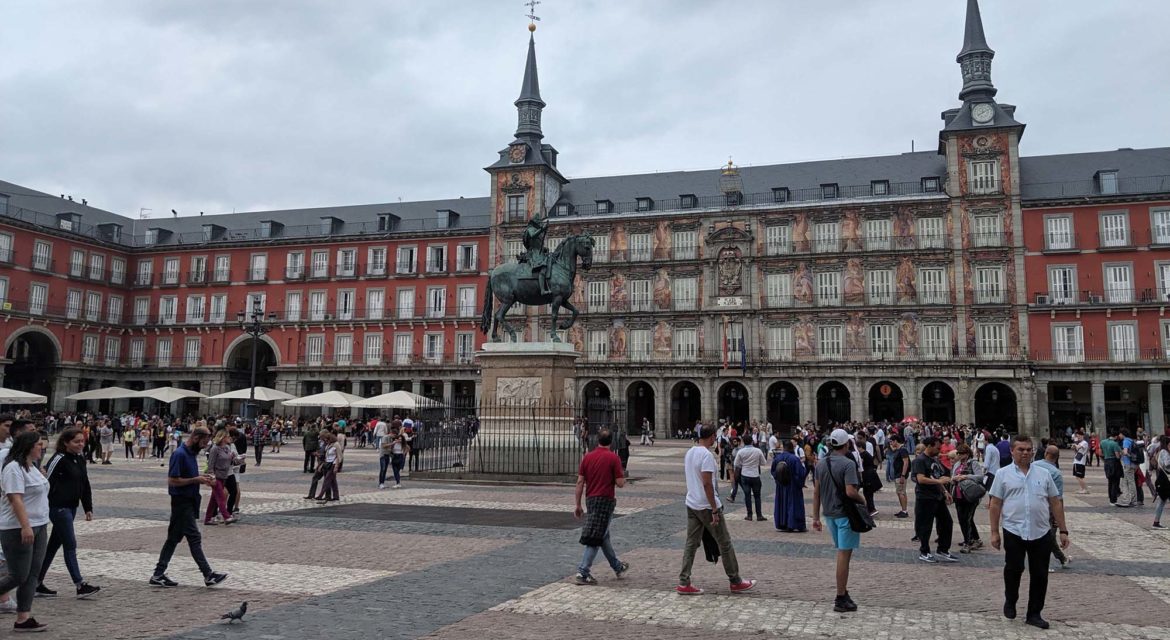 Plaza Mayor is major public square in the heart of Madrid, but it has come to mean something much more profound to both residents and tourists. With a history and presence that attracts people from across the capital of Spain and all of Europe, Plaza Mayor showcases what it can mean for a space to create an identity that helps define the culture of a city and region.
Plaza Mayor is major public square in the heart of Madrid, but it has come to mean something much more profound to both residents and tourists. With a history and presence that attracts people from across the capital of Spain and all of Europe, Plaza Mayor showcases what it can mean for a space to create an identity that helps define the culture of a city and region.

The Former Center of Old Madrid
 First built during the reign of Philip III in the 15th century, the area was originally called the Plaza del Arrabal and served as the center of Old Madrid. While it has been used as a marketplace for food and other goods, it’s also been the site of many events like bullfights, public executions, trials during the Spanish Inquisition and crowning ceremonies. In 1617, architect Juan Gómez de Mora was commissioned to create a greater uniformity amongst the buildings in the location, transforming it in an especially profound manner. At the end of the Spanish Civil War the plaza received its present name of “Plaza Mayor.“
First built during the reign of Philip III in the 15th century, the area was originally called the Plaza del Arrabal and served as the center of Old Madrid. While it has been used as a marketplace for food and other goods, it’s also been the site of many events like bullfights, public executions, trials during the Spanish Inquisition and crowning ceremonies. In 1617, architect Juan Gómez de Mora was commissioned to create a greater uniformity amongst the buildings in the location, transforming it in an especially profound manner. At the end of the Spanish Civil War the plaza received its present name of “Plaza Mayor.“
The statue of King Philip III on horseback in the center of the square is one of the most valuable works of art to be found on the streets of Madrid. Designed by Giambologna and completed by Pietro Tacca in 1616, it watched over the entrance to Casa de Campo for centuries until 1848 when Queen Isabel II placed it in Plaza Mayor. Further showcasing the history of the space is a Spanish Coat of Arms at the top center of La Casa de la Panadería. They are the royal Spanish arms from the reign of Carlos II.
Numerous fires have transformed the space, the most significant of which was a fire in 1790 which led to the reconstruction of the plaza by architect Juan de Villanueva. He lowered the building fronts by two stories, enclosed the square at its corners and constructed nine entrance arches, the most well-known of which is the Arco de los Cuchilleros with its steep steps leading up to the square.
Plaza Mayor has been the venue of royal lodgings, the San Fernando Royal Academy of Fine Arts and the History Academy. Today, it is home to countless shops and restaurants, including the Plaza Mayor Tourist Center. This history has informed the numerous experiences that both residents and visitors can have in the space.

Shop, Walk, Eat, and Enjoy
 The numerous events and activities that are available in Plaza Mayor have enabled it to become the epicenter of Madrid life. All of the stores and history that is on display across the space allow residents and visitors to shop, walk, eat and enjoy Plaza Mayor in whatever way they’d like. Direct and indirect revenue opportunities are associated with all of these elements and have also helped define the identity of numerous shops and businesses.
The numerous events and activities that are available in Plaza Mayor have enabled it to become the epicenter of Madrid life. All of the stores and history that is on display across the space allow residents and visitors to shop, walk, eat and enjoy Plaza Mayor in whatever way they’d like. Direct and indirect revenue opportunities are associated with all of these elements and have also helped define the identity of numerous shops and businesses.
Yoga workshops, concerts and festivals are just a few of the events that take place in Plaza Mayor throughout the year. However, the biggest event is undoubtedly the annual Christmas market, which has been held in the Plaza Mayor since 1860.
During this time period, the space becomes a huge market where citizens and tourists can find all types of Nativity Scene figures, Christmas musical instruments, toys and jokes. Decorations and lights are spread across Plaza Mayor which sees numerous vendors setting up market stalls and selling all sorts of holiday trinkets, decorations and more. The market even sells crazy wigs and gag gifts in honor of Spain’s version of April Fool’s Day, El Día de los Santos Inocentes, which falls on 28th of December.
Consistently rating as one of the top things to see and do in Madrid, Plaza Mayor showcases how squares of various types and sizes can create an identity for an entire city that means something distinct to residents and attracts visitors. Doing so has enabled numerous shops to sell merchandise that is directly associated with the space, all of which feeds into a legacy that means something to residents, visitors and to Madrid as a whole.
A Piece of Spanish Culture
 Located only a few blocks away from Puerta del Sol and the ubiquitous Bear and Strawberry Tree monument, Plaza Mayor has come to represent another piece of Spanish culture in a profound manner. In being used for everything from public celebrations to a place to relax to a shopping center while also being featured on countless souvenirs and in maps of the area, Plaza Mayor demonstrates what it can mean for a square to create an identity for a city and region.
Located only a few blocks away from Puerta del Sol and the ubiquitous Bear and Strawberry Tree monument, Plaza Mayor has come to represent another piece of Spanish culture in a profound manner. In being used for everything from public celebrations to a place to relax to a shopping center while also being featured on countless souvenirs and in maps of the area, Plaza Mayor demonstrates what it can mean for a square to create an identity for a city and region.


